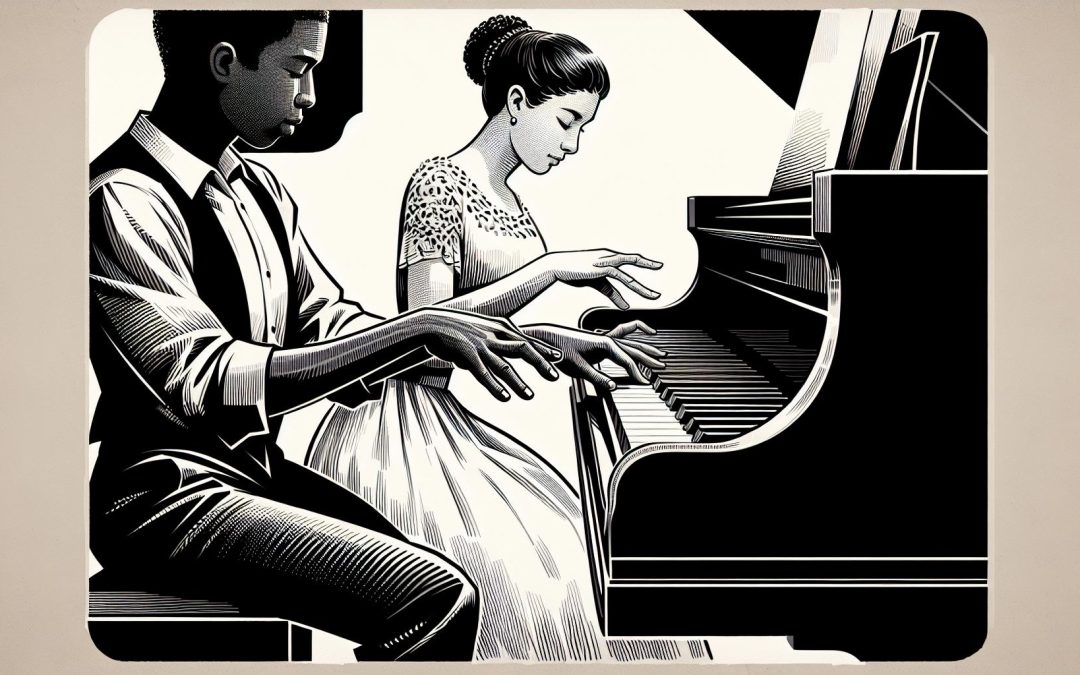When it comes to mastering the piano, every detail counts, from the way you sit to how your fingers strike the keys. One debate that's as old as the piano itself is whether it's better to play with flat fingers or curved fingers. This seemingly small aspect of technique can have a huge impact on a pianist's sound and comfort.
Both methods have their staunch advocates, each armed with compelling reasons why their approach is superior. On one side, the traditional curved fingers technique is praised for its ergonomic benefits and control. On the other, some find that flat fingers can offer a unique sound and may be more comfortable for certain people. Let's dive into the nuances of each technique and explore what makes them different.
Curved Fingers Technique
When exploring the myriad techniques for piano playing, the curved fingers approach stands out for its widespread endorsement among classical pianists and instructors. This technique, characterized by keeping the fingers gently curled as if holding an invisible ball, is lauded for its ergonomic advantages and its ability to facilitate swift, agile movement across the keys.
Advocates of the curved fingers method argue that this posture allows for better control and precision. Since each finger strikes the key with a similar part of the fingertip, pianists can achieve a more consistent tone and volume across different passages. This consistency is crucial for musical pieces that demand a high level of expression and dynamic range.
Moreover, the curved fingers technique is thought to reduce the risk of injury. By aligning the hand and forearm in a natural, relaxed position, pianists minimize strain on their muscles and joints. This ergonomic benefit not only enhances longevity in playing but also enables pianists to practice for longer periods without discomfort.
In terms of agility, the curvature of the fingers complements the natural movement of the hand. It allows for quick, dexterous transitions from one key to another, which is especially beneficial for pieces that require rapid, intricate finger work. The positioning of the fingers, in this case, helps in executing trills, arpeggios, and glissandos with efficiency and grace.
Another point often highlighted is the emotional expressiveness that the curved fingers technique allows. Since the fingers are more relaxed yet controlled, pianists can fine-tune their touch on the keys, from the softest pianissimo to the most resounding fortissimo. This control can make a considerable difference in the music's emotional impact, offering a wider palette of sonic textures to the performer.
Educators and professionals who teach piano also favor this method for beginners. They believe it establishes a solid foundation for proper hand positioning and muscle memory, which is crucial in the early stages of learning. Starting with the curved fingers technique can make it easier for students to adapt to different styles of playing as they advance in their musical journey.
Benefits of Playing with Curved Fingers

When it comes to mastering the piano, the distinction between playing with flat fingers and curved fingers is pivotal. Among the various techniques, the curved fingers approach stands out for its multitude of benefits.
Firstly, playing with curved fingers is inherently more ergonomic. This technique aligns with the natural curvature of the fingers, promoting a relaxed hand posture. It prevents the stiffness and strain that can come from playing with flat fingers, thus reducing the risk of repetitive strain injuries that are all too common among pianists.
Moreover, curved fingers offer enhanced control over the keys. This control is crucial for executing precise dynamics and articulations, from the gentlest pianissimo to the most thunderous fortissimo. The fingertips, with their sensitivity and agility, bring a level of nuance that flat fingers struggle to match.
Injury Prevention and Agility
A noteworthy advantage of employing curved fingers is the significant reduction in the risk of injuries. The ergonomic position means that musicians are less likely to suffer from tendinitis and carpal tunnel syndrome, both of which can prematurely end a pianist's career.
| Benefit | Description |
|---|---|
| Ergonomic Advantage | Aligns with natural finger curvature |
| Control Enhancement | Improves dynamic range and articulation |
| Injury Prevention | Reduces risk of tendinitis and carpal tunnel syndrome |
| Increased Agility | Facilitates swift transitions and expressive playing |
Agility is another key benefit. Curved fingers can move more swiftly between keys, which is indispensable for playing complex passages and fast-moving pieces. This agility also plays a role in emotional expressiveness, enabling pianists to convey the nuances of the music with greater ease and depth.
Expressive Playing
The role of curved fingers in expressive playing cannot be overstated. Alongside the technical benefits, this technique allows for a more profound emotional connection with the music. By utilizing the natural strength and flexibility of curved fingers, pianists can produce a wide range of tones, from the softest whisper to a powerful crescendo.
Advocates of this approach often note how it facilitates a direct transfer of the musician's emotions into the instrument, turning each performance into a deeply personal expression. This level of expressiveness is what distinguishes good pianists from truly great ones.
Flat Fingers Technique

While the curved finger technique has long been celebrated for its ergonomic benefits and enhanced control, the flat fingers technique holds its own unique advantages in piano playing. This approach, which involves playing with fingers that are more extended and less curved, can offer a different expressive quality and timbre to the music.
Expressive Qualities and Sound Variation
One of the most intriguing aspects of playing with flat fingers is the variation in sound and timbre it provides. Pianists who master this technique can produce a fuller and more resonant sound, due to the larger surface area of the finger making contact with the keys. This can be particularly effective in pieces that demand a rich, sonorous quality or when playing on a grand piano where the sound can truly bloom.
Furthermore, the flat fingers technique allows musicians to explore a range of expressive qualities not as easily accessible with curved fingers. For instance, they may find it easier to execute certain stylistic effects, like the delicate glissando or a soft legato, translating into a more nuanced performance.
Techniques for Beginners and Advanced Players
Beginners often start learning piano with a flat fingers approach as it feels more natural and requires less initial control than the curved finger technique. It offers a straightforward way to familiarize oneself with the keyboard layout and to start producing sounds without the added complexity of managing finger curvature.
For advanced players, incorporating flat fingers into their technique can aid in achieving greater dynamic range and emotional depth in their performances. It also provides diversity in their playing style, allowing them to switch between techniques to suit the musical genre or piece they are performing.
Potential Challenges and Considerations
However, adopting the flat fingers technique is not without its challenges. One key consideration is the potential for increased tension in the hand and forearm, as the muscles must work differently compared to when the fingers are curved. This requires careful attention to hand posture and relaxation techniques to prevent strain or injury.
Moreover, while flat fingers can enhance the richness of the sound, they may also limit the pianist's agility and speed, making it difficult to execute fast, complex passages with precision. Pianists using this technique need to be mindful of these potential limitations and work on exercises that enhance flexibility and speed without sacrificing the health of their hands.
Advantages of Using Flat Fingers

When exploring piano playing techniques, the advantages of using flat fingers often spark lively discussions among musicians. This approach, while perhaps less conventional than the curved fingers technique, brings its own set of benefits to the table that can significantly influence a pianist's expressive capabilities and sound production.
First and foremost, playing with flat fingers allows for a broader contact area between the fingers and the keys. This extended contact is not just about the physical connection; it translates into a richer, more resonant sound that's hard to achieve with curved fingers. Especially in pieces that require a grand, sonorous quality, the flat fingers approach can make a notable difference.
Moreover, the flat fingers technique offers a distinct clarity when executing glissandos and legatos, musical passages that demand a smooth, flowing movement over the keys. Thanks to the increased surface area in contact with the keys, pianists find they can glide more easily across the keyboard. This eases the production of these expressive elements, making them not only more achievable but also more impactful in performance.
Enhanced Expressive Quality
A key advantage of flat fingers lies in their ability to produce a unique expressive quality. This technique facilitates subtle nuances in dynamics and tonal color, elements essential for interpreting the emotional depth of various compositions. Whether it's the delicate whisper of a pianissimo or the bold statement of a forte, flat fingers give the pianist finer control over these dynamic ranges.
Furthermore, it's worth noting that the technique is particularly beneficial for certain genres of music. Jazz and blues pianists, for example, often favor flat fingers for their capacity to lay down smooth, flowing melodies and chords that are characteristic of these styles. The ability to seamlessly transition between notes and chords with a certain laid-back, fluid grace is something that the flat fingers technique accentuates beautifully.
Simplicity and Accessibility
For beginners, the flat fingers approach might seem more intuitive and less physically demanding. Since it's closer to the natural resting position of the hand, newcomers to the piano might find it easier to start with this technique. It offers a gentler learning curve, allowing students to focus more on the music and less on the intricacies of finger positioning.
Conclusion
Exploring the nuances between playing piano with flat versus curved fingers reveals a world of difference in sound quality and technique. While both methods have their merits, the flat fingers approach shines in its ability to produce a richer sound and more expressive performances. It's particularly appealing to those venturing into jazz and blues or beginners seeking a more accessible entry point into piano playing. Embracing this technique can open up new avenues for musical expression and deepen one's connection to the instrument. Whether you're a seasoned pianist or just starting out, considering how you engage with the keys can greatly influence your musical journey.
Harlan Kilstein began playing piano during covid with no piano background at all. He taught himself how to play learning what to do and what not to do.
Today he's an advanced intermediate player and can help you grow in your skills because he learned all this on his own.








